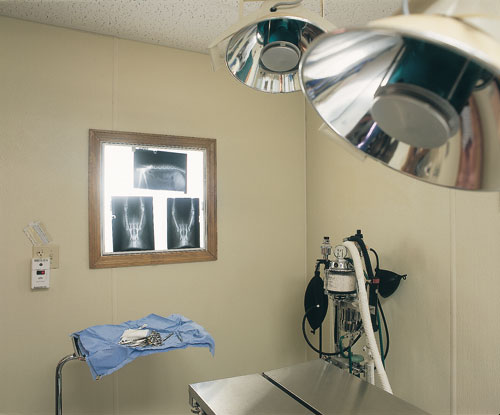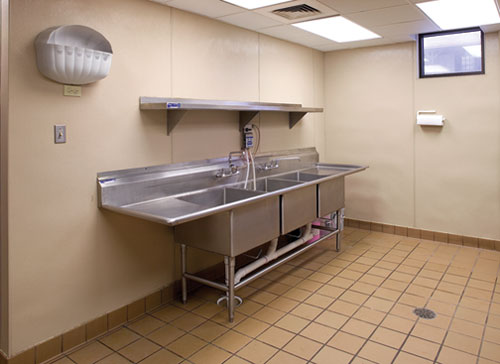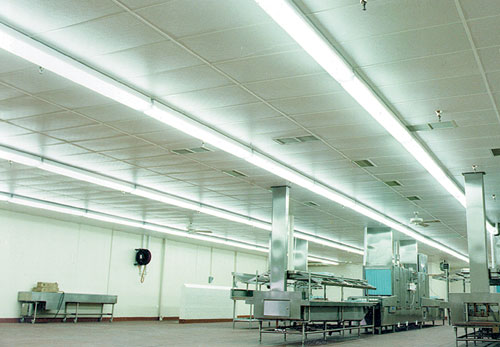Fiberglass Reinforced Plastic: High Performance in Ceiling and Wall Panels
FRP Ceiling and Wall Panel Applications
 |
Photo: Crane Composites, Inc. FRP panels can be used in many settings, including schools, restrooms or veterinary hospitals. |
FRP wall and ceiling panels are widely used throughout the construction and building materials industries. They are used extensively in commercial applications such as food, meat and dairy processing plants, labs and clean rooms, refrigerated warehouses, and chemical processing plants. FRP panels are also appropriate for restaurant kitchens, public washrooms, super markets and high traffic areas. Because of their sanitary properties, FRP panels are also used in the health care industry from nursing homes and day care centers and in educational settings from dormitories to schools and locker rooms.
Manufacturers offer a range of products to meet diverse design objectives. Lightly textured or high-gloss gel coat FRP panels can be used in "front room" areas where a sanitary and durable yet aesthetically pleasing finish is needed, as in an educational or public setting. FRP panels can also be laminated to a rigid substrate such as gypsum, plywood, fluted polypropylene, or oriented strand board, providing added structural strength and rigidity and allowing installation directly to studs on the wall or ceiling.
For "back room" areas where a sanitary and durable finish that meets USDA/FSIS requirements is required, FRP wall and ceiling panels can be sealed with a special protective finish that enhances their cleanability by ensuring that the panels remain mold and mildew free and moisture resistant. Such sealed panels have applicability in major restaurant chains where standardization is an important element of productivity and cost control. For example, every new and remodeled kitchen in the Pizzeria Uno eatery chain features smooth FRP panels with special sealants. Scot Durkin, Uno Restaurant Corporation's Director of Construction explains that the 2' x 2' panels with the special sealant will ultimately replace tile ceilings in every Pizzeria Uno kitchen. "In terms of washability the panels are superior to tile because there are far fewer cracks and seams in the ceiling," says Durkin, noting that the panels are "much easier and less costly to install." In addition, the treated FRP panels clean easily while retaining mildew resistance and corrosion prevention capabilities. Their smooth finish reflects the light, which brightens up the kitchens. Durkin reports that the specially treated Class C ceiling panels meet all Pizzeria Uno architectural specifications.
 |
Photo: Crane Composites, Inc. FRP is found in the kitchen areas of restaurants. |
Similar surface-treated FRP panels were listed as "no substitutions allowed" by B.I. Concept Systems, the franchise consulting and equipment services firm responsible for establishing construction standards for the washrooms and back room food preparation areas of Blimpie International's new franchise operations. Robert O. DeVillier III, Assistant Vice President Design for B.I. Concept Systems, claims the decision to replace standard FRP panels with the surface-treated version came down to quality. "According to the test samples we ran, the treated panels held up substantially better than competitive FRP," he says. "And because it's not as porous it offers a better solution for our sanitation needs."
Strict sanitation requirements and low maintenance are among the highest priorities for Rhodia, Inc., which serves the food industry as a primary source of bacterial starter cultures, enzymes and natural food colors. Rhodia used treated FRP panels for a multimillion dollar addition to its Madison, Wisconsin, plant. Some 800 sheets of specially treated panels were used, in 4' x 8' and 4' x 10'panel sizes. Standard panels were specified for most of the facility, and Class A fire-rated FRP panels were selected for "at risk" production areas. "Since production areas are thoroughly disinfected and hosed down on a shift-by-shift basis, cleanability is one of our major concerns," says Rod Dahlen, Rhodia Plant Manager. "Unlike a painted wall, the treated, non-porous FRP product does not harbor microorganisms."
Also available are FRP composite ceiling grid systems with improved fastening systems. The University of Connecticut at Storrs used such an improved FRP ceiling grid system on its new Agricultural and Biotech Building. Unlike many box-shaped university facilities, this building features a unique circular design with pie shaped rooms that required close attention to dimensions and ceiling grid layout. While fiberglass ceiling grid systems have traditionally been used because of their performance characteristics, they are sometimes cumbersome and time-consuming to install because of excessive amount of clips necessary to hold the system together. UCONN opted for an improved FRP ceiling grid with the traditional performance characteristics but with a notched locking mechanism that reduced the need for so many clips and made the entire grid system more stable. The main tee notches were positioned every six inches for cross tee connection, eliminating the need for junction clips that made the installation of the Class A fire-rated FRP 2' x 4' panels easier vs. the standard system which require the ceiling panel to be flexed in order to fit properly under the hold-down clips. The new system was "both faster and easier to install," says Bill DeMeola, Vice President of Thermal Fireproofing and Acoustics Company in West Haven, Connecticut, which installed the ceiling. DeMeola credits the new system with cutting installation labor time by up to one half.
 |
Photo: Crane Composites, Inc. Food processing area with FRP ceiling panels and a suspended fiberglass ceiling grid system |









